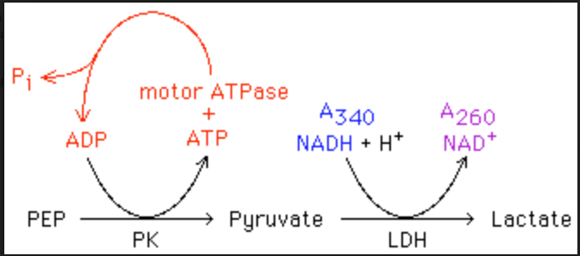Coupled assays are mentioned quite a lot through Rodionova et. al (2017)....as you might have noticed, it is the main experiment performed each time!
What is a coupled assay? A coupled assay is essentially the use of one enzymatic process to provide energy for the second enzymatic reaction. For example, in this paper, usually something is converted, and that is the substrate for the second reaction, and is most likely reduced.
For example, in Expt 1., PEP is converted to Pyruvate by PK during the oxidation of ADP to ATP, resulting in pyruvate. The pyruvate is used at the structure for the second enzymatic reaction, during which it is reduced to lactate by LDH during the oxidation of NADH to NAD+. Those are two enzymatic reactions that worked together to show the activity of PykF alone. ( Figure iv.)
At the beginning, HPr or HPr-P are added to an assay mixture containing several different concentrations of substrates: the only ones that are important are the ones that directly involved in aiding the allosteric regulation or inhibition of the E. coli. proteins. Then, that reaction mixture is incubated for a certain amount of time at a certain temperature. Incubation is essentially controlling the environment and outside variables, such as temperature, to stimulate growth or development of the reaction mixture. This is all to prep the HPr or HPr-P.
The E. coli protein is added to its 100 ul reaction mixture: in this one, as well, the only ones that are important are the ones directly involved in aiding the allosteric regulation or inhibition of the E. coli protein. The coupled assay is performed, and activity is graphed and measured through steady-state kinetics.
